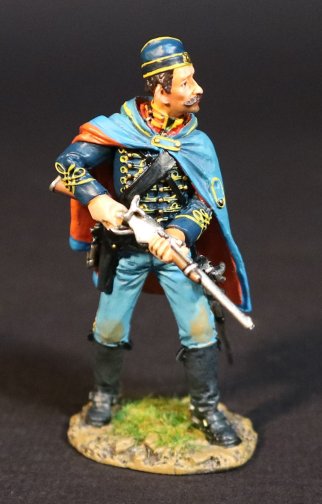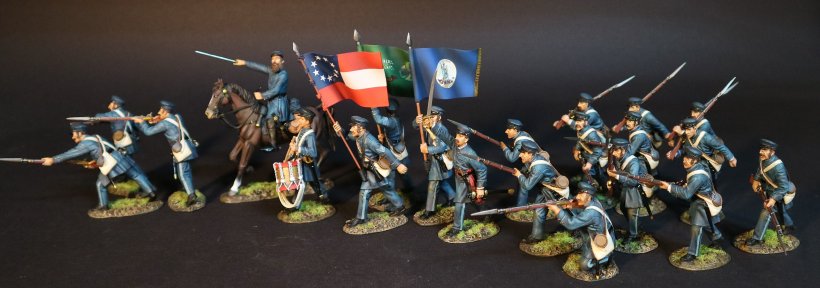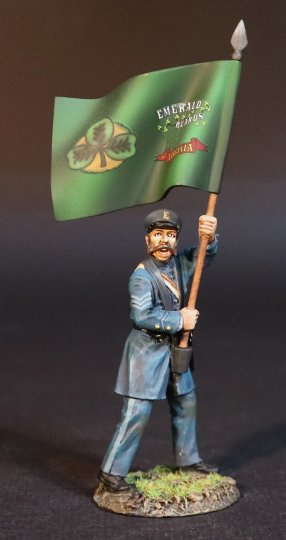- Joined
- Feb 2, 2011
- Messages
- 2,339
NEW RELEASES FOR MARCH 2024
THE AMERICAN CIVIL WAR
1[SUP]st[/SUP] CHEROKEE MOUNTED RIFLES
The 1[SUP]st[/SUP] Cherokee Mounted Rifles was a Confederate States Army regiment which fought in the Indian Territory during the American Civil War.

It was formed from the merger of two predecessor units, the First Regiment of Cherokee Mounted Rifles and the Second Regiment of Cherokee Mounted Rifles.
The first commander was Col. John Drew, while the commander of the second regiment was Stand Watie.

CHK-04
THE AMERICAN CIVIL WAR 1861 - 1865
THE CONFEDERATE ARMY,
1[SUP]st[/SUP] CHEROKEE MOUNTED RIFLES,
TROOPER.
(2 pcs)
Brigadier-General Stand Watie (December 12[SUP]th[/SUP], 1806 – September 9[SUP]th[/SUP] 1871) was a Cherokee politician who served as the second principal chief of the Cherokee Nation from 1862 to 1866.
The Cherokee Nation allied with the Confederate States during the American Civil War and he was the only Native American Confederate General officer of the war.
Watie commanded the forces in the Trans-Mississippi Theatre, made up mostly of Cherokee, Muskogee and Seminole.
He was the last Confederate Staes Army general to surrender.
During the Civil War, Watie's troops participated in twenty-seven major engagements and numerous smaller skirmishes. Although some of the engagements were set-piece battles, most of their activities utilized guerrilla tactics.
The Battle of Pea Ridge (March 7-8[SUP]th[/SUP], 1862) took place near Leetown, northeast of Fayetteville, Arkansas.
Pea Ridge was the first sizable battle of the Civil War to involve Native American troops, mostly because their current homeland lay only a few miles west of the battlefield. These Tribes, including the Cherokee, had lived in the Indian Territory, now the state of Oklahoma, ever since their removal from ancestral homelands in the southeastern states a quarter-century before the war.
Watie’s Mounted Rifles welcomed the opportunity to participate in the Pea Ridge Campaign, as it was a chance to show they were a worthwhile ally of the Confederacy.
They were to make a colourful and controversial contribution. During the battle the two Cherokee regiments, perhaps 1,000 strong along with 200 Texas cavalry, charged and took a three gun Union artillery battery.
They swept out of the woods, knocking down a fence in front of them, and charged across the field, swarming over a three gun battery before the startled crews could respond. The artillerymen fled with their horses, leaving the guns behind unspiked.
At this point experienced, disciplined troops would have established security, or continued the pursuit of their fleeing enemy. Neither was done. Instead the Cherokee milled around the guns they had taken, examining their prizes and collecting souvenirs. Others exhaulted in having survived, yelling and whooping victoriously.
It was a normal reaction for green troops after a first experience of combat, and one that was often repeated throughout those early years of the war.
The failiure of the officers to take charge of the situation was to cost them the fruits of their victory.
While the celebrations were taking place, Union officers deployed two additional batteries and supporting infantry to retake the guns.
The exploits of Stand Watie and his Confederate Mounted Rifles were brilliant and militarily glorious, but strategically sterile. Two years of raids could not loosen the Union grip on Fort Gibson.
The Cherokees not only were the most numerous of the Five Tribes, but they had assimilated more with white culture than the Choctaw, Creek, Chickasaw, or Seminole. They were the only Native Americans to create a written form of their language and they published a newspaper in that language. Many Cherokees adopted the white man’s dress and most began to utilize American farming methods. Cherokee lawyers brought cases defending their desire to remain in Georgia and North Carolina to the United States Supreme Court. A handful of elite Cherokees operated large plantations with African-American slave labor.
ARTILLERY

ACWART-15
THE AMERICAN CIVIL WAR 1861 - 1865
MODEL 1857 12 pdr. NAPOLEON HOWITZER,
STANDARD UNION TYPE.
(8 pcs)

ACWART-16
THE AMERICAN CIVIL WAR 1861 - 1865
MODEL 1857 12 pdr. NAPOLEON HOWITZER,
FIRST UNION TYPE.
(8 pcs)
THE 3[SUP]rd[/SUP] NEW JERSEY CAVALRY REGIMENT 1864.
“THE BUTTERFLIES”

Towards the war’s end most of the Federal cavalry were equipped and supplied via centralized depots, one of the units which stood out as belonging to another time and place was the 3[SUP]rd[/SUP] New Jersey Cavalry, or the “Butterflies”, a nickname they were given for their flamboyant attire.
Raised initially in January 1864 as the 1[SUP]st[/SUP] U.S. Hussars, they were dressed in such splendour previously unseen in other Federal cavalry regiments, which was deliberate in an attempt to attract new recruits.
Yet their appearance was deceptive, as they were the embodiment of what the Union cavalryman had become by 1865. They were heavily armed with repeating Spencer carbines and .44 Remington revolvers which gave them the edge in skirmishes and melees with rebel cavalry and infantry units.
The state paid for the additions to the regulation cavalry uniform, the cap was the issue forage cap with the peak removed, extra braid was placed on the jacket and the remainder was US army regulation.

US3NJ-02
THE AMERICAN CIVIL WAR 1861 - 1865
UNION ARMY OF THE POTOMAC,
3[SUP]rd[/SUP] NEW JERSEY CAVALRY REGIMENT, 1864,
“THE BUTTERFLIES”,
DISMOUNTED TROOPERS.
(3 pcs)
This unit was typical of the new horse soldier which served under General Sheridan, they no longer merely served as a screen for advancing infantry. They possessed tremendous fire power and had the ability to hit the enemy hard and fast. They had eveloved into a powerful force capable of independent action.
The 3[SUP]rd[/SUP] New Jersey would serve with distinction until the war’s end routing southern cavalry at Tom’s Brook, Virginia, and seeing action at the Battle of Five Forks, which helped force Lee’s battered army out of its fortifications around Petersburg.

US3NJ-02A
THE AMERICAN CIVIL WAR 1861 - 1865
UNION ARMY OF THE POTOMAC,
3[SUP]rd[/SUP] NEW JERSEY CAVALRY REGIMENT, 1864,
“THE BUTTERFLIES”,
DISMOUNTED TROOPER.
(1 pc)

US3NJ-02B
THE AMERICAN CIVIL WAR 1861 - 1865
UNION ARMY OF THE POTOMAC,
3[SUP]rd[/SUP] NEW JERSEY CAVALRY REGIMENT, 1864,
“THE BUTTERFLIES”,
DISMOUNTED TROOPER.
(1 pc)

US3NJ-02C
THE AMERICAN CIVIL WAR 1861 - 1865
UNION ARMY OF THE POTOMAC,
3[SUP]rd[/SUP] NEW JERSEY CAVALRY REGIMENT, 1864,
“THE BUTTERFLIES”,
DISMOUNTED TROOPER.
(1 pc)
THE AMERICAN CIVIL WAR
1[SUP]st[/SUP] CHEROKEE MOUNTED RIFLES
The 1[SUP]st[/SUP] Cherokee Mounted Rifles was a Confederate States Army regiment which fought in the Indian Territory during the American Civil War.

It was formed from the merger of two predecessor units, the First Regiment of Cherokee Mounted Rifles and the Second Regiment of Cherokee Mounted Rifles.
The first commander was Col. John Drew, while the commander of the second regiment was Stand Watie.

CHK-04
THE AMERICAN CIVIL WAR 1861 - 1865
THE CONFEDERATE ARMY,
1[SUP]st[/SUP] CHEROKEE MOUNTED RIFLES,
TROOPER.
(2 pcs)
Brigadier-General Stand Watie (December 12[SUP]th[/SUP], 1806 – September 9[SUP]th[/SUP] 1871) was a Cherokee politician who served as the second principal chief of the Cherokee Nation from 1862 to 1866.
The Cherokee Nation allied with the Confederate States during the American Civil War and he was the only Native American Confederate General officer of the war.
Watie commanded the forces in the Trans-Mississippi Theatre, made up mostly of Cherokee, Muskogee and Seminole.
He was the last Confederate Staes Army general to surrender.
During the Civil War, Watie's troops participated in twenty-seven major engagements and numerous smaller skirmishes. Although some of the engagements were set-piece battles, most of their activities utilized guerrilla tactics.
The Battle of Pea Ridge (March 7-8[SUP]th[/SUP], 1862) took place near Leetown, northeast of Fayetteville, Arkansas.
Pea Ridge was the first sizable battle of the Civil War to involve Native American troops, mostly because their current homeland lay only a few miles west of the battlefield. These Tribes, including the Cherokee, had lived in the Indian Territory, now the state of Oklahoma, ever since their removal from ancestral homelands in the southeastern states a quarter-century before the war.
Watie’s Mounted Rifles welcomed the opportunity to participate in the Pea Ridge Campaign, as it was a chance to show they were a worthwhile ally of the Confederacy.
They were to make a colourful and controversial contribution. During the battle the two Cherokee regiments, perhaps 1,000 strong along with 200 Texas cavalry, charged and took a three gun Union artillery battery.
They swept out of the woods, knocking down a fence in front of them, and charged across the field, swarming over a three gun battery before the startled crews could respond. The artillerymen fled with their horses, leaving the guns behind unspiked.
At this point experienced, disciplined troops would have established security, or continued the pursuit of their fleeing enemy. Neither was done. Instead the Cherokee milled around the guns they had taken, examining their prizes and collecting souvenirs. Others exhaulted in having survived, yelling and whooping victoriously.
It was a normal reaction for green troops after a first experience of combat, and one that was often repeated throughout those early years of the war.
The failiure of the officers to take charge of the situation was to cost them the fruits of their victory.
While the celebrations were taking place, Union officers deployed two additional batteries and supporting infantry to retake the guns.
The exploits of Stand Watie and his Confederate Mounted Rifles were brilliant and militarily glorious, but strategically sterile. Two years of raids could not loosen the Union grip on Fort Gibson.
The Cherokees not only were the most numerous of the Five Tribes, but they had assimilated more with white culture than the Choctaw, Creek, Chickasaw, or Seminole. They were the only Native Americans to create a written form of their language and they published a newspaper in that language. Many Cherokees adopted the white man’s dress and most began to utilize American farming methods. Cherokee lawyers brought cases defending their desire to remain in Georgia and North Carolina to the United States Supreme Court. A handful of elite Cherokees operated large plantations with African-American slave labor.
ARTILLERY

ACWART-15
THE AMERICAN CIVIL WAR 1861 - 1865
MODEL 1857 12 pdr. NAPOLEON HOWITZER,
STANDARD UNION TYPE.
(8 pcs)

ACWART-16
THE AMERICAN CIVIL WAR 1861 - 1865
MODEL 1857 12 pdr. NAPOLEON HOWITZER,
FIRST UNION TYPE.
(8 pcs)
THE 3[SUP]rd[/SUP] NEW JERSEY CAVALRY REGIMENT 1864.
“THE BUTTERFLIES”

Towards the war’s end most of the Federal cavalry were equipped and supplied via centralized depots, one of the units which stood out as belonging to another time and place was the 3[SUP]rd[/SUP] New Jersey Cavalry, or the “Butterflies”, a nickname they were given for their flamboyant attire.
Raised initially in January 1864 as the 1[SUP]st[/SUP] U.S. Hussars, they were dressed in such splendour previously unseen in other Federal cavalry regiments, which was deliberate in an attempt to attract new recruits.
Yet their appearance was deceptive, as they were the embodiment of what the Union cavalryman had become by 1865. They were heavily armed with repeating Spencer carbines and .44 Remington revolvers which gave them the edge in skirmishes and melees with rebel cavalry and infantry units.
The state paid for the additions to the regulation cavalry uniform, the cap was the issue forage cap with the peak removed, extra braid was placed on the jacket and the remainder was US army regulation.

US3NJ-02
THE AMERICAN CIVIL WAR 1861 - 1865
UNION ARMY OF THE POTOMAC,
3[SUP]rd[/SUP] NEW JERSEY CAVALRY REGIMENT, 1864,
“THE BUTTERFLIES”,
DISMOUNTED TROOPERS.
(3 pcs)
This unit was typical of the new horse soldier which served under General Sheridan, they no longer merely served as a screen for advancing infantry. They possessed tremendous fire power and had the ability to hit the enemy hard and fast. They had eveloved into a powerful force capable of independent action.
The 3[SUP]rd[/SUP] New Jersey would serve with distinction until the war’s end routing southern cavalry at Tom’s Brook, Virginia, and seeing action at the Battle of Five Forks, which helped force Lee’s battered army out of its fortifications around Petersburg.

US3NJ-02A
THE AMERICAN CIVIL WAR 1861 - 1865
UNION ARMY OF THE POTOMAC,
3[SUP]rd[/SUP] NEW JERSEY CAVALRY REGIMENT, 1864,
“THE BUTTERFLIES”,
DISMOUNTED TROOPER.
(1 pc)

US3NJ-02B
THE AMERICAN CIVIL WAR 1861 - 1865
UNION ARMY OF THE POTOMAC,
3[SUP]rd[/SUP] NEW JERSEY CAVALRY REGIMENT, 1864,
“THE BUTTERFLIES”,
DISMOUNTED TROOPER.
(1 pc)

US3NJ-02C
THE AMERICAN CIVIL WAR 1861 - 1865
UNION ARMY OF THE POTOMAC,
3[SUP]rd[/SUP] NEW JERSEY CAVALRY REGIMENT, 1864,
“THE BUTTERFLIES”,
DISMOUNTED TROOPER.
(1 pc)



